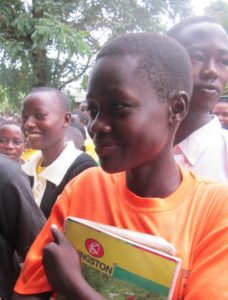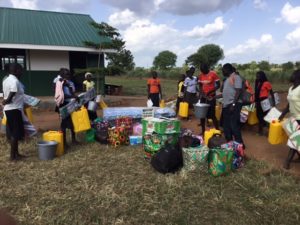Part 3: School
In the first article in our series on recognizing the barriers to girls’ education in South Sudan, we identified four spheres of society in which barriers are present: family, school, community, and national. In the second article of the series, we focused on the family sphere and the barriers associated with it, as well as the interventions that Africa ELI has used to help our students overcome those barriers. In this third article, we explore school-level barriers and explain the interventions we use in counteracting them.As of 2017, more than 70% of children in South Sudan are not receiving an education –– the highest proportion in the world; and since the civil war erupted in 2013, almost a third of all schools have closed.
In Africa ELI’s work toward increasing safe and uninterrupted access to secondary education in South Sudan, we have identified the following school-level barriers to girls’ education:
- Location and number of schools
- Environmental dangers
- Curriculum quality
- Teacher quality
- Conflict and instability
Location and Number of Schools
Secondary schools are not available throughout all of South Sudan. The majority are located in urban areas, leaving rural areas neglected. This leads to higher dropout rates in rural areas. Lack of infrastructure, under-qualified teachers, inconsistent teacher pay, and scarcity of resources limits the construction of, access to, and continuous staffing for schools.
Location proves to be a barrier with respect to distance between home and school. First, there is the the danger of traveling in South Sudan, and girls are especially at risk of being assaulted as they walk to school. Second, because of the distance and cost of school, a family may prioritize the education of sons, keeping daughters at home.
By the Numbers
- In 2015, only 10% of students entered secondary school and 3% completed.
- In 2016, there were 1,407, 276 students; 20,181 of whom were females in secondary school, with 3,527 passing their secondary school leaving exam (Sudan and South Sudan curricula).
- In 2016, there were 34 female students enrolled in secondary school for every 100 males.
- In 2016, there were only 213 secondary schools in South Sudan. Of those, 44 are located in one state (Yei River).
Africa ELI scholarship distribution has totaled 2,282 since 2008. Many of the recipients have been orphaned, widowed, or are young mothers from 10 of the (former) states of South Sudan and Nuba Mountains.
Environmental Dangers
Safety is a primary concern with respect to the school environment itself. As of 2016, 25% of secondary schools in South Sudan are partially or completely destroyed, raising the danger of injury from debris, environmental toxins, and even latent land mines. Schools that are open may have intermittent electricity or none at all.
Health is also a concern. Eight percent of secondary schools are without access to drinking water, 94% are without a health clinic, 83% are without a first aid kit, and 62% are without fencing. Fear of additional conflicts and unsafe access to schools, as well as poorly constructed schools, prevent many students from attending.
Africa ELI sponsorship of girls includes payment for health services, toiletries and sanitary napkins. The relocation of students to Uganda, which Africa ELI undertook in response to the outbreak of fighting in 2016, removed students from significant and immediate danger. That action represents the most significant intervention in support of student safety that we have undertaken thus far.
Curriculum Quality
On September 8, 2015, the South Sudan Ministry of Education, Science & Technology launched the first comprehensive national education curriculum for South Sudan. Prior to the launch of the national curriculum, there were no comprehensive curricula in South Sudan. Some schools were using a South Sudan curriculum, while others were using curricula from Uganda, Kenya, Ethiopia, or Sudan.
Language of instruction can be a barrier for many students. English is the official language of instruction, yet some students, as well as teachers, are not proficient in English. This can prevent students from understanding the curriculum and being able to complete assignments, creating discouragement and leading to students dropping out.
Africa ELI routinely hires tutors to assist students in improving their English language skills. Additionally, we have provided textbooks to schools with Africa ELI sponsored students to enhance existing curricula and help prepare students for national exams.
Teacher Quality
South Sudan faces challenges of teacher shortages, untrained or under-trained teachers, insufficient teacher pay, and low teacher attendance.
Gender parity in the profession is also a concern: In 2016, only 9% of secondary teachers were females. Girls need professional females as role models, and to know there are employment opportunities for women.
Africa ELI offered three seminars for secondary school teachers in South Sudan, presented in 2011, 2012, and 2015. Professional educators from the United States addressed topics based upon requests from the teachers in Yei. Seminar material and discussions covered cultural and gender dynamics, participatory teaching methods, and classroom management.
Partnering with expatriates and local community professionals, Africa ELI has coordinated Career Days. Speakers are requested to inform students about career achievements and challenges, educational experiences, and advice for achieving career goals.
Conflict and Instability
The increase of conflict across South Sudan in 2016 and 2017 has adversely affected the ability to provide continuous education services. In regions of the country where schools remain closed, internally displaced persons and armed militants seek shelter in school buildings. Whether due to occupation, destruction, or lack of resources, schools are unable to serve their intended purpose.
The situation continues to worsen: According to the UNICEF South Sudan Country Office, there were a higher number of weeks of education lost in 2016 compared to 2015, with 16% of schools losing more than a month of schooling. Schools in many counties have remained closed since July 2016.
Africa ELI continues to monitor the fragile situation in South Sudan and adapt to fluid circumstances. Through daily communication, and based on advice from South Sudanese partners, we are able to continue supporting the education of the nation’s daughters in East African locations deemed secure and safe.
References
South Sudan Ministry of General Education & Instruction
UNESCO, 2016
UNICEF, 2015
UNICEF, 2017



